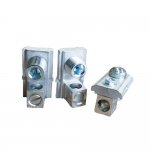Coppersmith
Senior Member
- Location
- Tampa, FL, USA
- Occupation
- Electrical Contractor
A client of mine who is a solar contractor has installed the system depicted below. His approved drawing calls for a line side tap. The inspector says this is a supply side tap. It's on the line side of the panel but the supply side of the MB. What is the correct answer?
If that is a supply side tap, does moving the tap to the line side of the MB make it a line side tap? Note that there is already a tap ahead of it to another panel.
He used those taps that bite into the wire. If those are removed, can the insulation be repaired with tape (vinyl or rubber) and stay compliant? If not, could he leave them in place and just disconnect the tap wires and be compliant?

If that is a supply side tap, does moving the tap to the line side of the MB make it a line side tap? Note that there is already a tap ahead of it to another panel.
He used those taps that bite into the wire. If those are removed, can the insulation be repaired with tape (vinyl or rubber) and stay compliant? If not, could he leave them in place and just disconnect the tap wires and be compliant?



